Things to do while in Québec City
Have you ever visited a new place only to find out that you had missed the best of it when you got back home? You have already been in Québec but would like to step off the beaten path and discover something new? If so, read on…
For those who prefer guided tours
For those who prefer guided tours and excursions, optional tours and activities are also offered as part of the conference program. See the complete list of tours page.
For those who prefer to wander at their own pace
For those who prefer to be on their own, you will find below a list of activities and walking tours to do while you are in town. You can also visit the Québec City tourism office pages here.
- Discover Québec City
- Guided St-Lawrence Cruise
- Observatoire de la Capitale
- Dufferin Terrace
- The Fortifications
- The Citadel
- Battlefield Park
- Promenade Samuel-De-Champlain
- The Wendake Huron village
- Parc national de la Jacques-Cartier
- Montmorency Falls
- Apple picking
Discover Québec City Double Decker Hip On/Hop Off
Description
The best excursion to discover and explore the Québec City you have been looking for. Historical, romantic, fashionable, fun and shopper friendly. Hop on, hop off the red loop as often as you please, and see Québec City on your own time and at your own pace. 11 stops at Québec City's top sites. Enjoy fantastic views from the open top deck. It’s le Bus rouge!
Recommendation
Good shoes, warm clothes, camera

Photo: Claudel Huot
Guided St-Lawrence Cruise
Description
Set sail with the costumed guide of the Louis Jolliet. This cruise on the St Lawrence River will allow you to discover the history of Québec City, the river and the surroundings. The cruise extends from the Cap Diamant to the Montmorency Falls.
Boarding: 11h00 am, 1h30 pm and 3h30 pm
Departure Point: Chouinard Pier
Recommendation
Warm clothes, camera
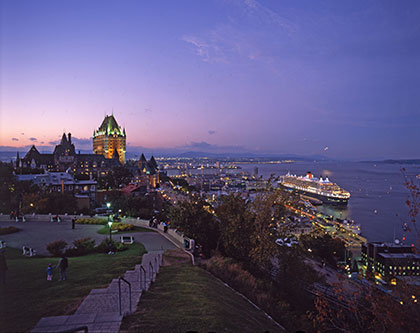
Photo: Yves Tessier
Observatoire de la Capitale
Description
Visit the Observatoire de la Capitale, an observatory atop a 221-meter tower offering a stunning panoramic view a few steps away from the Congress Centre.
The perfect way to get yourself oriented in the City
Recommendation
Good shoes, warm clothes, camera.

Photo: Jean-François Bergeron, Environ-Photo
Dufferin Terrace
Description
The Dufferin terrace is by far the most visited tourist attraction in Québec City. You can see the water slowly run to the Gulf of St. Lawrence, and you will have a breathtaking view on the South shore, the Île d'Orléans, the Old-Port and, of course, the Château Frontenac.
All summer, the terrace is alive with street artists, musicians, mimes, one-man bands, and many others. You can also see the canons that were used to defend the city more than once throughout the centuries. Come see the Samuel de Champlain monument as well as the one dedicated to generals Wolfe and Montcalm, who both died during the famous battle of the Plains of Abraham.
Recommendation
Camera.
Photo: Jean-François Bergeron, Environ-Photo
The Fortifications
Description
The fortifications surrounding Old Québec are close to 4.6 km in length. As you walk the walls, you'll learn about the defence system of North America's only remaining fortified city. Take a guided tour of Québec City's fortifications and admire the views. Visit the Frontenac kiosk on Dufferin Terrace as well as Artillery Park and its unique building interiors near the Saint-Jean Gate.
More than just the vestiges of military art of war, the Fortifications of Québec bear witness to the era of fortified cities between the 17th and 19th century.
When within Québec's defence system, one can sense that the military's presence dominated the city. The parade grounds, esplanades, military arteries, casemate, and warehouse, in which munitions and artillery paraphernalia were stored, are remnants of a city's past that was punctuated by the beat of the war drum.
Recommendation
Good shoes, camera.
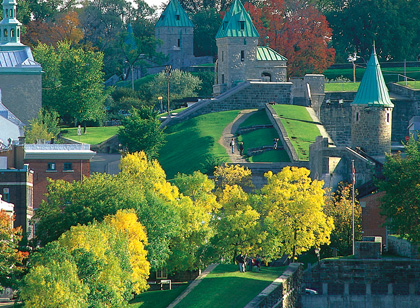
Photo: Sebastien Larose
The Citadel
Description
Nicknamed the "Gibraltar of America", the citadel was built between 1820 and 1850 and is the largest British fortress built in North America.
It is located atop Cap Diamant, the highest natural point in the area. Find out about its critical role in the city's defence system.
Why did Québec City have to have a fortress? What explains its shape, like a star when seen from above? What goes on within its walls today? These and other questions will be answered along the way.
Visit the Citadel, an active military base where visitors can watch the changing of the guard or explore the Governor General’s official residence.
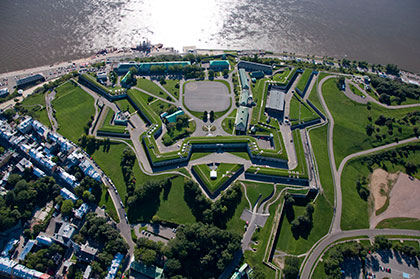
Photo: David Robert
Battlefield Park
Description
The Plains of Abraham was the site of many clashes for supremacy between the French and British Empires, the park is the scene of the 1759 Conquest, which changed the fate of North America.
Apart from its historical past, the park is to Québec what Central Park and Hyde Park are to New York and London: a city park of outstanding value, the lungs of the city. One hundred and three hectares of meadow and grassy knolls, decked with flowers or covered with snow, are there for residents and visitors to enjoy.
The Plains are perfect for all kinds of activities (walking, cycling, picnicking, cross-country skiing, and more) or simply meeting up with friends.
Recommendation
Good shoes, camera

Photo: Pierre Laurin
Promenade Samuel-De-Champlain
Description
This vast 2.5-kilometer long park was inaugurated in 2008 as a gift from the government of Québec to the capital for its 400th anniversary. The park, which runs between boulevard Champlain and the St. Lawrence River, restores access to the mighty waterway for Québec City residents.
Recommendation
Warm clothes
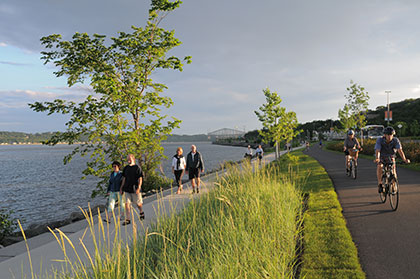
Photo: Chantal Gagnon
The Wendake Huron village
Description
Enter the fascinating world of the Huron-Wendat First Nation and embark on a history tour that will take you back to the 17th century. The ancestral site of Wendake is a window onto aboriginal culture! Dance shows and legends will whisk you deep into this people's imagination, while Musée huron-wendat and various craft stores invite you to learn more about the nation's culture and traditional know-how.
A short walk through scenic natural surroundings leads visitors to Kabir Kouba Falls by Rivière Saint-Charles, and sampling the game featured in traditional Huron cuisine is the perfect way to round out your voyage of discovery.
Recommendation
Camera
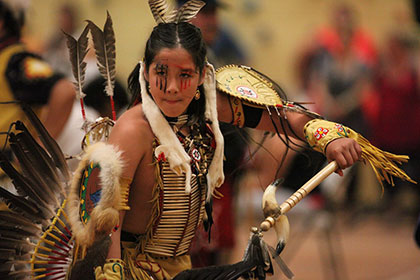
Photo: Jean-Luis Regis
Parc national de la Jacques-Cartier
Description
The spectacular Rivière Jacques-Cartier flows through a deep valley surrounded by steep wall soaring up to 550 m in height! Parc national de la Jacques-Cartier is protected by Québec's parks and outdoor recreation network so that you can enjoy all your favorite outdoor pursuits.
With hiking, canoeing, kayaking, fishing, and camping all available in breathtaking surroundings, it's no wonder that the Jacques-Cartier region is known locally as Québec City's “green crescent.”
Recommendation
Good shoes, warm clothes, camera.
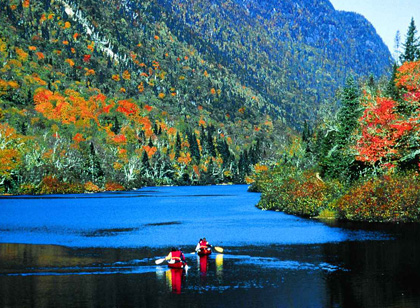
Photo: Jean-François Bergeron, Enviro Foto
Montmorency Falls
Description
On the Côte-de-Beaupré, ten minutes away from the Convention Centre, discover the 272 feet high (83 m) Montmorency Falls, a natural masterpiece that is one and a half times higher than Niagara Falls. Get close the falls, climb to lookouts on the cliff, or simply take the cable car to have a breathtaking walk over the falls.
Recommendation
Good shoes, camera, warm clothes and/or rain clothes if you intend to get close to the action…
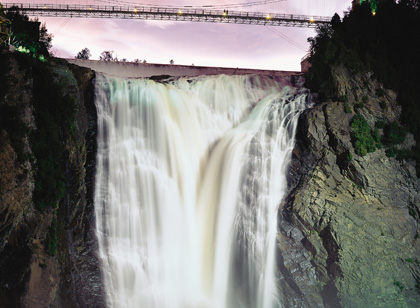
Photo: Yves Tessier
Apple picking
Description
Apple picking is a cherished fall tradition in Québec, and the area boasts many orchards surrounded by breathtaking landscapes—great for taking colorful photos! September and October are the perfect months for picking different varieties of apples and enjoying processed products including apple butter and jelly, apple pastries, cider, and ice cider. Many sites are open to the public so you can fill your bag with apples as you create beautiful memories.
Recommendation
Good shoes, warm clothes, camera.
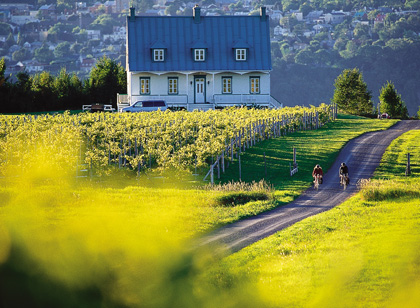
Photo: Sebastien Larose
